JSC Zelenodolsk plant is building six patrol ships of the Project 22160 class that is named after A. M. Gorky and intended for use by the Russian Navy’s Black Sea Fleet command. The vessels are designed by Russian ship designing firm JSC Severnoye Design Bureau.
The vessels are primarily intended for duties such as patrol, monitoring and protection in the exclusive economic zone (EEZ) and territorial waters of Russia in open and closed seas. It can also be used to offer protection for ships in transit, water areas as well as naval bases against enemy attack in wartime.
Other missions of the patrol ship are search and rescue, assistance to disaster victims, environmental monitoring, and combat smuggling and piracy activities.
Construction details of Project 22160 class patrol ships
Keel for the lead ship in the Project 22160 class, designated Vasily Bykov, was laid in February 2014 and is expected to be commissioned into the Russian Navy in 2017.

Dmitry Rogachev – Максим
Construction on the second patrol ship in the series, named Dmitry Rogachev, began in July 2014. Keel laying ceremony of the third ship, designated Pavel Derzhavin, was held in February 2016.
Deliveries of all six vessels are expected for completion by 2020.
Project 22160

russianships.info
Ships
Shipyard named after A.M.Gorky, Zelenodolsk
|
Name
|
Yard №
|
Laid Down
|
Launched
|
Commissioned
|
Note
|
|
Vasily Bykov
|
№161
|
26.02.2014
|
08.2017
|
20.12.2018
|
|
|
Dmitriy Rogachev
|
№162
|
25.07.2014
|
8.04.2018
|
11.06.2019
|
|
|
Pavel Derzhavin
|
№163
|
18.02.2016
|
21.02.2019
|
plan 2020
|
under construction, Zaliv Shipyard, Kerch |
|
Sergey Kotov
|
№164
|
8.05.2016
|
–
|
plan 2021
|
under construction, Zaliv Shipyard, Kerch |
|
Viktor Velikyy
|
№165
|
25.11.2016
|
–
|
plan 2022
|
under construction |
|
Nikolay Sipyagin
|
№166
|
13.01.2018
|
–
|
plan 2023
|
under construction |
Source russianships.info
Project 22160 class design and features

pwo.su
Featuring modular design, the Project 22160-class patrol ship is 94m-long, 14-m-wide, and 3.4m- high, has a standard displacement of 4,550t, and can accommodate up to 80 personnel.

Vasily Bykov – Новости на Первом Канале

Vasily Bykov – Новости на Первом Канале

Vasily Bykov – Новости на Первом Канале
The vessel is equipped with a telescopic hangar and helicopter deck with facilities at the aft to facilitate take-off, landing and maintenance of one 12t rescue helicopter such as Kamov Kа-27 PS. An inflatable boat can be carried for patrol and transportation tasks.

Vasily Bykov – russiadefence.net

Vasily Bykov – russiadefence.net

Vasily Bykov – Russian Navy

Телеканал Звезда

russiadefence.net
Project 02800 assault landing boat

russiadefence.net
Project 02800 assault boats are suitable for high-speed naval operations and delivery of assault groups on shore. It can also provide fire support for marines and conduct patrol operations.
The boat has shallow draft and armored shell, and can reach a speed of 75kph, with excellent maneuverability. It can operate both on the open sea and near the coast.
Among its key advantages are stealth and on-board capability. The 10-meter long, 3.6-meter wide boat can hold 12 military personnel, which it is able to put ashore in the blink of an eye.
It was first presented by St. Petersburg’s Ferrumland factory at the International Maritime Defense Show (IMDS-2017) in July. Source rt.com

Телеканал Звезда
General characteristics – Project 02800
| Displacement (tons): |
| Standard: |
6,5 |
| Full load: |
10 |
| Dimensions (m): |
| Length: |
10 |
| Beam: |
3,6 |
| Draft: |
– |
| Speed (knots): |
40 |
| Range: |
– |
| Autonomy (days): |
1 |
| Propulsion: |
2×420 hp diesels, 2 pump-jets |
| Complement: |
2+10 |
Source russianships.info
Russian corvettes will have complexes with two drones

Russian patrol ships of project 22160 will equip drones to search for submarines, survey ships and shorelines, and to provide targeting, according to Izvestiya. In the future, uavs can be used to solve impact problems. According to the defense ministry currently modular unmanned systems preparing for the tests. All equipment, including the operator, can fit in one or two standard containers that can be installed on the deck of the corvette. “The complex includes two unmanned helicopters bpv-500, constructed according to the coaxial scheme. Maximum take-off mass of the uav is 500 kg, body length less than 5 m and payload up to 150 kg. The machine can stay aloft for up to five and a half hours and to operate up to 320 km from the carrier”, – the newspaper writes with reference to the military. Coaxial circuit provides a drone high precision hovering and makes them less sensitive to gusts of wind. It is clarified that for the collection of information used optical-electronic system and airborne radar. Source weaponews.com
Russia’s Radar MMS BPV-500 unmanned helicopter
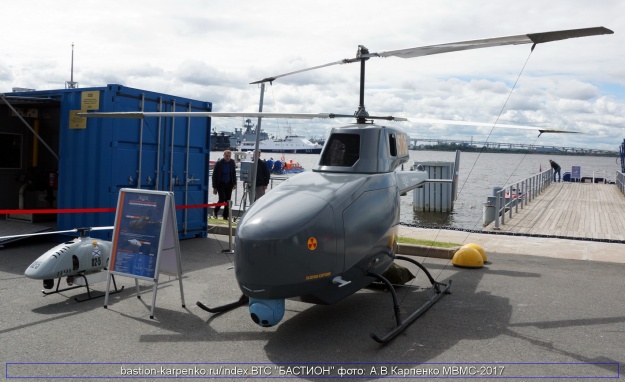
foto-i-mir.ru
Russia-based Radar MMS released further details of its BPV-500 vertical-takeoff and landing (VTOL) unmanned aircraft system (UAS) at the MAKS 2017 airshow in Zhukovsky near Moscow.
Radar MMS representative Sergey Prokofiev told Jane’s that the BPV-500 is designed to operate from land and naval vessels, and is intended to fill a range of mission sets.
“The BPV-500 has been designed in accordance with global VTOL UAS development tendencies. Military bodies and law enforcement agencies can use the vehicle to conduct search-and-rescue [SAR], patrol, and counter-insurgency [COIN] missions,” he said.
A complete UAS consists of a single BPV-500 air vehicle, ground control elements that feature two work stations, communications equipment, and a set of payloads for the aircraft. The control stations can be fitted on board naval vessels or integrated on ground vehicles.
Prokofiev explained that the air vehicle is based on a Rotor-Flight helicopter and utilises only Russian-built components. Source uasvision.com

OPERATING CONDITIONS
| Ambient temperature, ºС |
-30 … + 50 |
| Relative humidity of environment at 35 ºС |
<98 |
| Wind speed near the ground, m / s |
<12 |
| Intensity of precipitation in the form of rain and snow, mm / h |
<5 |
SPECIFICATION
| Take-off weight, kg |
500 |
| Weight of payload equipment, kg |
180 |
| Diameter of the main rotor, m |
6.2 |
| Duration of flight, h |
8 |
| The radius of action of the BPW, km |
500 |
| Cruising speed of horizontal flight, km / h |
180 |
| Vertical lift speed, m / s |
7.0 |
| Dynamic ceiling, m |
4000 |
| Dimensions of the HPV (Length / Width / Height), m |
6.1 / 1.9 / 2.85 |
| Equipped with a BPV: an internal combustion engine with a silencer, fuel-gasoline A-95; power supply of equipment-battery |
|
| Navigation systems: Onboard inertial navigation system; Satellite navigation (GPS, GLONASS) |
Armament of Project 22160
The Project 22160-class is armed with one 57mm А-220М naval artillery weapon on the bow of the main deck. With a rate of fire of 300rpm, the gun is designed to defeat air, surface and coastal targets. Two 14.5mm heavy machine guns are mounted on the bridge deck.
Redut and Pantsir-M anti-aircraft complexes
Project 20386 corvettes and project 22160 patrol ships will receive container Redut and Pantsir-M anti-aircraft complexes. The Defense Ministry has decided to create a container anti-aircraft complexes and has already formulated tactical and technical requirements for them, according to Izvestia, with reference to the Main Committee of the Russian Navy. Source topwar.ru
57mm А-220М naval artillery weapon

Vasily Bykov – russiadefence.net
This 57-mm automatic rapid-fire naval gun is an upgraded version of А-220 naval gun. It has successfully passed extended trials and is recommended for service introduction.
А-220М is a multipurpose system designed to engage air, surface and coastal targets. It may be installed on surface ships with the displacement of 250 ton and more such as missile boats of 205/ 20970 projects and others.
The gun operates at the ambient temperature from -40° С to +50° С provided the ship’s speed is below 45 knots.

Vasily Bykov – Russian MoD
The naval gun consists of:
– an automatic gun unit comprising a barrel and a breech with a wedge breechblock and a cradle. Integrated with the cradle, there are a cross-feed mechanism, a rammer, a trigger, an empty case extractor, recoil and counterrecoil brakes and a barrel-cooling system;
– a carriage with an artillery unit, an ammunition feed mechanism and quick electrohydraulic actuators with gun laying systems and hydraulics;
– a magazine with a double-lead screw for ammunition storage and feed. The magazine is attached to the collector in the bottom part of the carriage;
– a cupola made of aluminium alloy;
– a fire control panel interfacing the artillery mount with any fire control system that provides total laying angles;
– an automatic command and control system.

А-220М gun fires case ammunitions developed for S-60 with 53-UOR-281U HE projectiles.
There are 400 rounds in the magazine; the rest munitions can be stored in special racks under the deck. The munitions are fed from the magazine by the feed screw through a transferring mechanism to the collector connected with the vertical elevator. From the elevator receiver the munitions are transferred to the harp transporter of the gun unit. Coming to the last position on the transporter, the ammunition descends to the ramming line. Then the round is rammed and fired.
The feeding mechanisms of the gun oscillating mass are recoil-operated. The transfer of rounds from the magazine to the oscillating mass receiver is power-driven. Empty cases are ejected into the gun under-turret area. Ammunitions are reloaded to the magazine between firing activities.

Vasily Bykov – Россия. Кубань
The gun’s Automatic Command and Control System provides the means of control required for the gun preparation for combat operation and firing as well as continuous diagnostics of the gun system and status data transferring. It also allows the operators training without activating the main gun mechanisms.
The power is supplied to the gun from the ship’s electric system:
– power equipment – 3-phase, 380 V, 50 Hz;
– switching, alarm and fire circuits – 27 V DC.
Consumed power = 14 kW. The cooling system uses sea water under pressure 5.5 – 8.0 kgf/cm², the flow-rate = 5.3 ltr/s. Source burevestnik.com
2 x 14.5mm heavy machine guns

Vasily Bykov – Телеканал Звезда
14.5 mm marine pedestal machine-gun mount (14.5 mm MTPU) is intended for fight against lightly armoured surface, coast and air targets. It is mounted on decks of war boats and ensures defeat of surface and coast targets at the distances of up to 2000 m at the height of up to 1500 m.
Cartridges with armour-piercing-incendiary bullet B-32, armour-piercing-tracer bullet BZT and incendiary of instant action MDZ are used for firing at surface, coast and air targets.
| Technical Characteristics |
| Weapon |
machine-gun KPVT |
| Machine-gun calibre, mm |
14.5 |
| Rate of fire, shot/min, not less |
450 |
| Mass of a mount with a machine-gun (without ammunition and SPT&A),kg |
350 |
Overall dimensions (with the height
of foundation from the deck 100 mm), mm:
length
width
height |
2800
865
1500-1800 |
| Angle of elevation guidance, degrees |
-15 to +60 |
| Angle of traverse guidance, degrees |
±180 |
| Direction of a machine-gun feed |
right |
| Method of guidance |
manual |
| Crew, persons |
1 |
Data zid.ru
The ship is also equipped with two DP-65 grenade launchers and one Gibka air defence missile turret mount, armed with eight Igla man-portable air defence systems. It is optionally offered with one Club-N integrated missile system as well as one Shtil-1 air defence system with two 3S90E.1 modular launchers.
1 x Gibka air defence missile
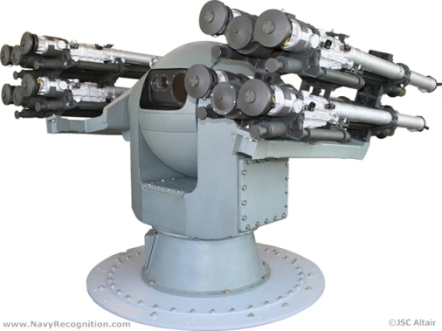
Mission
The Gibka turret mount for Igla-type MANPADS is designed to assist aiming and remote-controlled launching of Igla surface-to-air missiles used to defend surface ships, displacing 200 and more tonnes at a very short close-in range against enemy anti-ship missiles, aircraft and helicopters in the conditions of background clutter and enemy jamming.

Composition
– shipborne missile launch turret that mounts an optronic receiver unit, a rotary support unit, and Strelets commonised launch modules, with two missiles in each. One turret mount can accommodate from two to four launch modules with a total ammunition load varying from four to eight missiles respectively;
– control module is an operator’s workstation with a monitor, a control panel, and a computer;
– power supply system.
Features
Standard shipborne facilities are used to search for and acquire aerial targets. The target data is fed from them into the Gibka system, and its operator completes the search, locks on, and tracks targets. Igla SAMs are aimed and launched at a target by the operator from the control panel. Igla/Igla-S fire-and-forget missiles have optical passive seekers with IR jamming signal discriminators to guide them to the target. Source roe.ru
1 Shtil-1 Air Defense System with two 3S90E.1 modular launchers

The weight of the missile is 581 kg, including the 62 kg blast fragmentation warhead initiated by a dual-mode radar proximity fuze. Dimensions of the hull are 5.18 m length; 0.36 m maximum diameter. Range is 2.5–32 km in a 3S90M “Shtil-1” naval missile system. Altitude of targets from 15 m up to 15 km (and from 10 m to 10 km against other missiles). 9M317ME missiles can be fired at 2-second intervals, while its reaction (readiness) time is up to 10 s.
9M317ME missile

Club-N integrated missile system

by selena3D
Mission
High-performance submarine-based Club-S and ship-based Club-N integrated missile systems are designed to engage surface ships and submarines in conditions of intensive enemy fire and electronic countermeasures. Both systems employ unified combat assets – two types of anti-ship cruise missiles and an anti-submarine ballistic missile. Club-N missile system features standardized launch units and transport-launch containers.
Composition
Integrated missile systems include:
- 3M-54E anti-ship cruise missile (Club-S) comprises a booster, low-altitude subsonic sustainer, and a separable supersonic warhead. 3M-54TE ASM (Club-N) features a TLC to ensure vertical launch;
- 3M-54E1 ASM (Club-S) comprises a booster and a low-altitude subsonic sustainer. 3M-54TE1 ASM (Club-N) differs from 3M-54E1 only by having a TLC;
- 3M-14E land-attack cruise missile (Club-S system) consists of a booster and a low-flying subsonic sustainer. Launched from the Club-N system this missile is designated the 3M-14TE, with the only difference being a TLC;
- 91RE1 anti-submarine ballistic missile (Club-S) performs a controlled flight to the target area. Its separable warhead is a high-speed homing torpedo with a sonar target seeker.
91RTE2 anti-submarine ballistic missile (Club-N) differs from 91RE1 missile in size and booster design
Source roe.ru
3M-54E ASM

Flateric
The SS-N-27 Sizzler or 3M-54 Klub missile is designed to destroy submarine and surface vessels, but also has the capability to engage static or slow moving ground targets. There are two modifications to this missile known to be used by the Russian military. The Klub-S for submarines and the Klub-N for surface vessels. The difference between the two modifications being the design of the missile launchers and transport containers. The Sizzler has a max range of 300 km, travelling 10-15 m above the surface at high subsonic speeds. Perhaps the most effective feature of the Sizzler is during its third solid-fuel stage where it accelerates to supersonic speeds; increasing the difficulty associated with missile defense intercept. Another advantage is the Sizzler’s size, just under 2000 kg, which allows it to be deployed onto most naval ships in large quantities. The Sizzler’s high cruising speed during its final stage and the missile’s advanced guidance system make it an effective weapon of choice for the Russian Navy.

Kalibr launch from small missile boat Grad Slavyazhsk – southfront.org
Facts
| Russian/NATO Designation |
3M-54 Klub/SS-N-27 Sizzler |
| Variants |
3M-54E, 3M-54E1, 3M-14E, 91RE1, 91RE2 |
| Mobility and Role |
Submarine and Ship Launched Anti-Ship Cruise Missile |
| Designer/Producer |
Novator Experimental Design Bureau |
| Range |
220-300 km |
| Warhead Type and Weight |
Conventional 1920 kg; Reported Nuclear |
| MIRV and Yield |
No MIRV/450 kg |
| Guidance System/Accuracy |
Inertial; TERCOM; GPS; DSMAC /reported 3m CEP |
| Cruise Altitude |
10-15 m |
| Stages/Propellant |
3/Solid |
| IOC/Retirement |
1987/Still Active |
| Status/Number of Units |
Operational/Unknown |
| Launch Vehicles |
Sub-Surface Ships – Kilo, Lada, Akula, Yasen, Borei class submarines;Surface Ships – Admiral Gorshkov, Admiral Grigorovich, Gepard, Gremyashchy, second batch of Steregushchy, and Buyan-M class ships
Containers and Transport Erector Launchers |
Source missiledefenseadvocacy.org
3M-14E

Flateric
Russia’s Kalibr cruise missiles are believed to be the land-attack version the Klub family cruise missiles, yet, not much is currently known about these variations. The 3M-14TKalibr-NK is a land-attack cruise missile carried by Russia’s surface vessels. Reports put its max range at 1,500 – 2,500 km. In October and November 2015, Russia launched a salvo of Kalibr missiles from the Caspian Sea at ISIS targets inside Syria. The Kalibr-NK cruise missiles were launched from a Russian Gepard-class frigate and Buyan-M-class corvettes and travelled 1,500 km to reach their targets. It has been reported it is capable of carrying a 450 kg conventional or (reported) nuclear warhead.
The missile is believed to fly 64 ft above the sea and 164 ft above the ground at speeds up to 965 km/hour. It is believed to be guided, using GPS and terminal-phase active radar seekers to achieve a reported three m CEP. The 3M-14K Kalibr-PL is similar to the 3M-14T except that is launched from a submarine. This variant was reported to have been launched from an improved Kilo-class submarine in the Mediterranean to strike targets inside Syria in December 2015. Russia plans to equip most of its submarines and surface ships with the respective versions of the Klub anti-ship and Kalibr land-attack cruise missiles. This will include ships in Russia’s Baltic Sea, Black Sea, Caspian Sea, Northern, and Pacific Fleets. Novator Design Bureau, the designers of the Klub launch system, have developed a shipping container version of the launcher, capable of holding up to four missiles. This shipping container version allows the cruise missile to be forward deployed on ships, trucks, and trains without detection.

missilethreat.csis.org
Facts
| Russian/NATO Designation |
3M-14 Kalibr/SS-N-30A |
| Variants |
3M-14T Kalibr-NK; 3M-14K Kalibr-PL |
| Mobility and Role |
Sea Launched Strategic and Tactical Land-Attack Cruise Missile |
| Designer/Producer |
Novator Design Bureau |
| Range |
1,500-2,500 km |
| Warhead Type and Weight |
Conventional -450 kg; Reported Nuclear |
| MIRV and Yield |
1 x Unknown |
| Guidance System/Accuracy |
Inertial; TERCOM; GPS; Terminal-Phase Active Radar Seeker/Reported 3 m CEP |
| Cruise Altitude |
20 m over sea; 50 m over ground |
| Stages/Propellant |
2/1st liquid-fuel booster; 2nd solid-fuel turbojet engine |
| IOC/Retirement |
Oct. 2015/Unknown |
| Status/Number of Units |
Operational/Unknown |
| Launch Vehicles |
Kalibr-PL (sub-surface ships) – Kilo, Lada, Akula, Yasen, Borei class submarines; Kalibr-NK (surface ships) – Admiral Gorshkov, Admiral Grigorovich, Gepard, Gremyashchy, second batch of Steregushchy, and Buyan-M class ships |
Source missiledefenseadvocacy.org
91RTE2 anti-submarine ballistic missile

The 91RTE2 Club-N is a ship-based ballistic missile designed to engage submarines using its payload which includes a small-size MPT-1UME torpedo fitted with an active homing head. It is suitable for engagements of hostile submarines located at 40 km using a built-in Inertial Navigation System (INS) to reach the target area. The 91RE1 and 91RTE2 ballistic missiles differ in size and booster design. They are expected to replace the SS-N-15 and SS-N-16 missiles in the Russian Navy.

Dimensions
Diameter: 533 millimeter (21.0 inch)
Length: 6.50 meter (256 inch)
Performance
Max Range: 40,000 meter (21.6 nautical mile)
Speed
Top Speed: 664 mps (2,391 kph)
Weight
Warhead: 76 kilogram (168 pound)
Weight: 1,300 kilogram (2,866 pound)
Source deagel.com
2 x DP-65 grenade launchers

tonnel-ufo.ru
It is designed for protection of ships against attacks of underwater combat swimmers at external roadstead open anchor stops and bases, for protection against attacks of underwater combat swimmers at water-development works, sea platforms and other important sea and coastal installations.
It is mounted both on the ships (sea installations) and on the coastal installations.
The system ensures single-shot and salvo fire with rocket grenades RG-55M and RGS-55.
Guidance of the system and fire control is carried out remotely or manually. Rocket grenades launching in manual control mode is carried out by the autonomous power source.

RG-55M
The control panel and the power source provide the possibility of simultaneous connection of one to four grenade launchers.
The system is equipped with blocking device ensuring security of loading and unloading of the grenade launcher, blocking of firing circuits in the zones forbidden for firing.
Detection of a target is performed with the sonar dipping station. When using the system with the sonar “ANAPA-ME” automatic detection of the target, guidance of the system by the sonar to the target and its tracking up to defeat is ensured.

Vasily Bykov – Телеканал Звезда
| Technical Characteristics |
|
| Calibre, mm |
55 |
| Quantity of barrels |
10 |
| Angle of elevation guidance, degrees |
-33 to +48 |
| Angle of traverse guidance, degrees |
-165 to +165 |
| Speed of elevation guidance, degrees/s |
10 |
| Speed of traverse guidance, degrees/s |
15 |
| Range of fire, m |
minimum 50
maximum 500 |
| Mass of the grenade launcher (without grenades), kg |
132 |
| Overall dimensions of the grenade launcher, mm |
970×780×1820 |
Source zid.ru
Countermeasures
The onboard PK-10 close-range decoy dispensing system offers protection against electro-optical guided weapons and radars. A TK-25 ship-based electronic countermeasure system is used to deceive sonar, radar and lasers.
PK-10 «Smely» Electronic CounterMeasures (ECM) system (KL-121 launcher)

Launcher – 10 trunks, two types of static installation on the deck – up trunks and at an acute angle to the horizon.
Caliber – 120 mm
shell length – 1,220 mm
Installation length – 655 mm (without shells)
installation width – 962 mm (without shells)
Installation height – 540 mm (without shells)
shell weight – 25 kg
Unit weight without rotating mechanism – 205 kg
Weight of a rotary mechanism – 336 kg
Ammunition – projectiles have the same weight and size characteristics and differ only in equipment warhead.
Application :
– MRK pr.1234
– MRK pr.1239 “Bora” (4 installed on the ship aft)
– Small artillery ships pr.21630 “Brawler”
– Dr.tipy ships
TK-25E Electronic CounterMeasures (ECM) system

The TK-25E shipborne electronic suppression system is designed to intercept emissions of airborne and shipborne target acquisition radars, weapons control radars and anti-ship missile radar seekers, to perform automatic signal classification, to determine most dangerous approaches of attacks against the ship, and to provide jamming in threat directions.
TK-25E’s configuration depends on carrier-ship type and displacement

Source roe.ru
Navigation and communications

Dmitry Rogachev – Новости на Первом Канале

Dmitry Rogachev – Новости на Первом Канале

Dmitry Rogachev – Новости на Первом Канале
Fitted atop the bridge, a Pal-N ship borne navigation radar is used to scan, detect, identify and track air or surface targets for safe manoeuvring. A Pozitiv-ME1 air / surface flat phased array search radar, also located on the top of the bridge, is designed for the detection and tracking of air and surface targets.
Pozitiv-ME1 air / surface flat phased array search radar
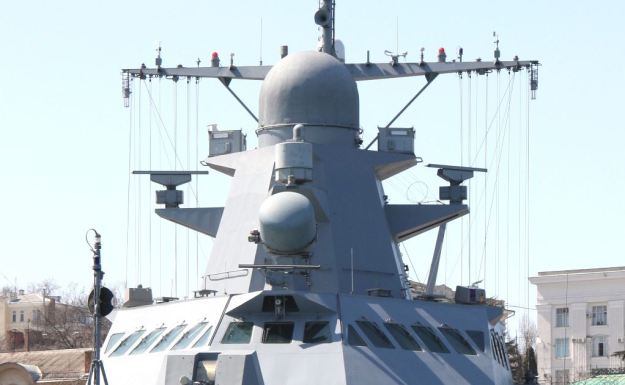
Vasily Bykov – russiadefence.net
Pozitiv-ME and Pozitiv-ME1.2 3D active shipborne radars are designed to search, detect and track air and surface targets. Radars are mounted at small- and medium-displacement ships and are an integral self-contained part of multi-purpose electronic system.

Pozitiv-ME family radars perform the following tasks:
- air/surface sea-situation surveillance;
- search, detection and tracking of surface and air targets, including small-size, low-flying, and dive ones;
- target detection and tracking in preselected sectors with automated mode selection depending on the ECM environment;
- state identification of detected targets (”friend-or-foe”) by IFF equipment and built-in antennas;
- target coordinates and motion parameters determination;
- target classification according to trajectory parameters;
- target threat prioritisation;
- automatic target distribution and plan display with on-line correction possibility;
- targeting data feed to weapons and other cooperating systems;
- automatic operational modes selection and operability control and trouble-shooting;
- recording of target data processing output, worked-out solutions, and interfaced system status;
- staff training in simulated radar environment.

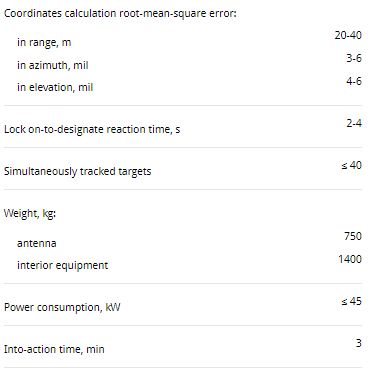
Source roe.ru

Vasily Bykov – Телеканал Звезда
MR-123 radar system (LASKA)

Features
•Self-sustained acquisition and identification of radar-contrast targets in circular and sector scanning modes;
•Track-while-scan of up to four air/surface/coastal tar-gets in one-layer circular or sector surveillance mode;
•Fire control of one or two artillery gun mounts of various calibres against one aerial or two surface targets(among the tracked ones);
•Reception of designation data from ship’s surveillance radars and mono-pulse tracking of one target with firing data generation;
acquisition and lock on the attacking missile launched from the tracked target with solution of the engagement priority problem.
Mission
Laska fire control radar is designed to monitor surface/air situation and to control fire of 30mm-76mm close-range shipborne artillery systems against air/missile and small-size surface targets.
Composition
•surveillance and precision tracking radar
•integrated laser/TV channels
•fire control system comprising display and control panel
•interfaces with artillery mounts and ship systems

Source roe.ru
Pal-N ship borne navigation radar

Vasily Bykov – Россия. Кубань
NRLS “PAL-N” is intended for the circular radar review, detection, an identification and auto maintenance of the found surface purposes with development of recommendations on a safe divergence and tactical maneuvering

ru.all.biz

ru.all.biz
A Pallada sonar system aboard the patrol ship detects and tracks divers, while a Vinyetka-EM active / passive sonar system detects the surface ships, submarines and torpedoes. The ship is also fitted with a MGK-335EM-03 sonar system on the hull.
Pallada sonar system

Vasily Bykov – Телеканал Звезда
Mission
Pallada sonar is designed for underwater detection in the active mode of combat swimmers with (and without) their delivery vehicles, from the stopped ship. The sonar is capable of classifying and tracking up to three detected targets.

military-discussion.com
Composition
- receiving/emitting acoustic antenna
- single-unit switchboard/receiver-amplifier
- control console, comprising data processing and control equipment, video monitor and transceiver
Features
The sonar provides a 360-deg underwater coverage, and its acoustic array can be dipped to a depth of up to 20 m. Electronic equipment housed in the junction box and control console serves to emit, receive and process hydroacoustic signals. All relevant data is represented on a display panel with a keyboard and a trackball. Pallada sonar is controlled by one operator. Source Rosoboronexport

Vasily Bykov – russiadefence.net
MGK-335EM-03 sonar system (?)

charly015.blogspot.com

oceanpribor.ru
Propulsion and performance of the patrol vessels
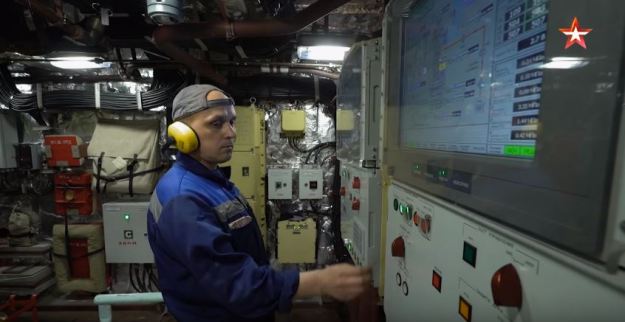
Vasily Bykov – Телеканал Звезда
The Project 22160-class is driven by CODAG (combined diesel and gas) type propulsion system with a total output power of 25,000kW. Electrical systems installed in the ship include four 300kW diesel-generators and one 100kW emergency and harbour diesel generator.
Kolomna 16D49 diesel engine

Vasily Bykov – Телеканал Звезда

kolomnadiesel.com
Kolomensky plant sent the customer a diesel-reverse-gear unit for the main power plant of the new patrol ship
As part of the import substitution program, Kolomensky Zavod OJSC manufactured and manufactured a diesel-reverse gear unit DRRA6000 for OAO Zelenodolsky Plant named after AM Gorky to be installed on a new 22160 patrol ship Dmitry Rogachev.
The diesel-reverse gear unit DRRA6000 is designed to work on a propeller of a fixed pitch. The main ship power plant of the project includes two units – ДРРА6000 and ДРРА6000-01 (each with a capacity of 6000 hp), which are located on the left and right sides of the ship. Each unit consists of a 16D49 diesel engine built by the Kolomna plant, a reverse gear drive produced by PJSC Zvezda and a local control system from JSC Concern NPO Avrora.

Diesel-reverse gear unit DRRA6000
The patrol ship “Dmitry Rogachev” – the first serial ship of the project 22160, was laid at the Zelenodolsk plant in July 2014. The main ship of the project “Vasily Bykov” was equipped with a power plant of MAN (Germany).
A total of 6 ships of Project 22160 will be built at the Zelenodolsk Plant. All of them will replenish the Black Sea Fleet until 2020. Source kolomnadiesel.com
The patrol and maximum speeds of the ship are 16kt and 30kt respectively. The ship has a cruising range of 6,000mi at patrol speeds and an endurance of 60 days.
General characteristics – Project 22160
| Displacement (tons): |
| Standard: |
– |
| Full load: |
1965 |
| Dimensions (m): |
| Length: |
91,3 |
| Beam: |
4,5 |
| Draft: |
4,8 |
| Speed (knots): |
22,5 |
| Range: |
6000 nmi |
| Autonomy (days): |
60 |
| Propulsion: |
2×6000 hp 16D49 diesels, 4×300 kW diesel-generators, 1×100 kW diesel-generator, 2 fixed pitch propellers |
| Armament: |
1 Ka-27PS helicopter
1 high-speed assault boat Project 02800
9K338 «Igla-S» SAM system (8 9M342 missiles)
1×1 76 mm AK-176MA-01 – MR123-02/3 «Bagira» fire control system
2×1 14,5 mm MTPU-1 «Zhalo»
1×10 55 mm DP-65 grenade launcher (RG-55M, GRS-55 grenades)
2×2 45 mm DP-64 grenade launchers (SG-45, FG-45 grenades) |
| Electronics: |
TK-25E Electronic CounterMeasures (ECM) system, «Pallada» anti-saboteur sonar
PK-10 «Smely» Electronic CounterMeasures (ECM) system (KL-121 launcher) |
| Complement: |
32+8 |
Source russianships.info
Main material source naval-technology.com
Images are from public domain unless otherwise stated
Revised Aug 6, 2019


































































